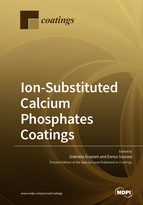Ion-Substituted Calcium Phosphates Coatings
A special issue of Coatings (ISSN 2079-6412). This special issue belongs to the section "Surface Coatings for Biomedicine and Bioengineering".
Deadline for manuscript submissions: closed (31 August 2020) | Viewed by 38484
Special Issue Editors
Interests: calcium phosphates; nanostructured coatings; biomaterials; infection; 3D printing and bioprinting; orthopaedics; orthopaedic oncology; tissue models; cultural heritage; stone consolidants
Special Issues, Collections and Topics in MDPI journals
Interests: calcium phosphates; hydroxyapatite; stone; mortar; masonry; consolidation; mechanical properties; durability; composite materials; hemp
Special Issues, Collections and Topics in MDPI journals
Special Issue Information
Dear Colleagues,
Coatings based on hydroxyapatite and calcium phosphates have a significant relevance in several research fields, such as biomaterials, cultural heritage and water treatment, due to their characteristic properties.
Hydroxyapatite can easily accommodate foreign ions, which can either be incorporated into the lattice, thanks to its specific lattice characteristics, or be adsorbed on its surface. All these substitutions significantly alter the morphology, lattice parameters and crystallinity of hydroxyapatite, so they influence its main properties. These ion substitutions can be desired or can derive from substrate contaminations, which is an important aspect to be evaluated. Finally, this capability can be used to obtain hydroxyapatites with specific properties, such as, among others, antibacterial characteristics.
For these reasons, the aim of this Special Issue is to document current advances in the field of ion-substituted hydroxyapatites and highlight possible future perspectives regarding their use. Contributions in the form of original articles and review articles are encouraged, covering different areas of application.
In particular, the topics of interest include, but are not limited to, the following:
- Synthesis or deposition of ion-substituted calcium phosphate coatings.
- Nucleation of calcium phosphate coatings in the presence of substrate contaminations.
- Antibacterial ion-substituted hydroxyapatites.
- Ion-substituted hydroxyapatites for different applications.
- Relevance of specific ion substitutions (e.g., magnesium, strontium, sodium) on the properties and/or the behavior of substituted hydroxyapatites.
- Novel techniques to improve the control over ion-doping of calcium phosphates.
- Advanced characterization techniques to investigate the properties of the coatings (composition, morphology, mechanical properties, solubility, crystallinity, ion release in different media etc…).
Dr. Gabriela Graziani
Dr. Enrico Sassoni
Guest Editors
Manuscript Submission Information
Manuscripts should be submitted online at www.mdpi.com by registering and logging in to this website. Once you are registered, click here to go to the submission form. Manuscripts can be submitted until the deadline. All submissions that pass pre-check are peer-reviewed. Accepted papers will be published continuously in the journal (as soon as accepted) and will be listed together on the special issue website. Research articles, review articles as well as short communications are invited. For planned papers, a title and short abstract (about 100 words) can be sent to the Editorial Office for announcement on this website.
Submitted manuscripts should not have been published previously, nor be under consideration for publication elsewhere (except conference proceedings papers). All manuscripts are thoroughly refereed through a single-blind peer-review process. A guide for authors and other relevant information for submission of manuscripts is available on the Instructions for Authors page. Coatings is an international peer-reviewed open access monthly journal published by MDPI.
Please visit the Instructions for Authors page before submitting a manuscript. The Article Processing Charge (APC) for publication in this open access journal is 2600 CHF (Swiss Francs). Submitted papers should be well formatted and use good English. Authors may use MDPI's English editing service prior to publication or during author revisions.







